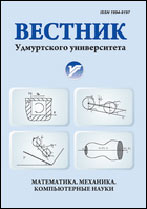|
|
Vestnik Udmurtskogo Universiteta. Matematika. Mekhanika. Komp'yuternye Nauki, 2014, Issue 1, Pages 66–75
(Mi vuu417)
|
 |
|
 |
MATHEMATICS
Modeling the velocity field of two-layered creeping flow and some geophysical applications
V. V. Pak
Laboratory of Geophysical Hydrodynamics, V. I. Il'ichev Pacific Oceanological Institute, Far Eastern Branch of the Russian Academy of Sciences, ul. Baltiiskaya, 43, Vladivostok, 690041, Russia
Abstract:
We study the long-time evolution of axisymmetric free-surface two-layered creeping flow subject to the initial topography of its boundaries and bottom velocities. Each layer has uniform density and viscosity. The upper layer is assumed to have a smaller density than the lower layer. Based on lubrication approximation (the Reynolds equations) the nonlinear system of diffusion-type equations with respect to the surface and interface between the layers is obtained to describe this flow. Taking the dimensionless density contrast between the layers as a small parameter, we apply the method of asymptotic expansions to extract leading-term approximation for the slowly varying large-time evolution of the governing equations. An asymptotic equation relating both surface and interface displacement to the bottom velocities is derived. Based on this equation, we develop the algorithm to calculate velocity fields within layers for large time. Streamlines are used to visualize the flow. Numerical results reveal stability of the streamlines in the upper layer under variation of the bottom velocity. As geophysical applications, the developed algorithm is used to evaluate the velocity field in the crust (the upper layer) beneath the large-scale lunar multi-ring basins influenced by deep movements in the underlying mantle (the lower layer). To validate the results of modeling, we compare the calculated velocity fields with basin ridge systems obtained by experimental observations. The model comparison has shown proximity of radii of basin rings and critical points of the surface velocity.
Keywords:
multi-layered flow, long-wave approximation, Reynolds equations, nonlinear diffusion, ring structures.
Received: 21.11.2013
Citation:
V. V. Pak, “Modeling the velocity field of two-layered creeping flow and some geophysical applications”, Vestn. Udmurtsk. Univ. Mat. Mekh. Komp. Nauki, 2014, no. 1, 66–75
Linking options:
https://www.mathnet.ru/eng/vuu417 https://www.mathnet.ru/eng/vuu/y2014/i1/p66
|

|




 Contact us:
Contact us: Terms of Use
Terms of Use
 Registration to the website
Registration to the website Logotypes
Logotypes








 Citation in format
Citation in format 